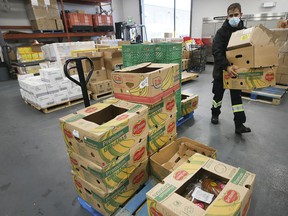
Article content
Hunger is cruelly invisible in our society.
Commercial
This ad has not been uploaded yet, but your article continues below.
Article content
Although it may surround us, we hardly see it. But it is always there. With the latest hunger tally released by Canada’s food banks, we now have a better idea of how the pandemic has affected Canada’s food insecurity landscape.
The news is not good.
According to an internal survey of food bank operators, the number of visits has increased by more than 20 percent in the last two years. The largest increases observed were in Quebec, Ontario and Alberta. In Saskatchewan, Nova Scotia and New Brunswick, the rate of visits to the food bank decreased, but not by much.
More Canadians go hungry, while our cost of living skyrockets. It is not likely to be easier any time soon.
According to the report, food banks in larger urban centers were more likely to see very high increases in visits, likely driven by unemployment and layoffs related to the pandemic. They were also more likely to see racialized groups.
Commercial
This ad has not been uploaded yet, but your article continues below.
Article content
Food banks in smaller urban centers were more likely to serve the elderly and people with disabilities. As a result, the report also claims that the pandemic has magnified systemic inequalities in our society, despite all the programs implemented during the pandemic, worth more than $ 400 billion.
During the pandemic, a total of $ 200 million was added to the Emergency Food Security Fund so that food banks, related agencies and indigenous organizations can continue to help struggling Canadians put food on the table during the pandemic. of COVID-19. That funding was understandably beneficial to the food bank network during these unprecedented times.
The pandemic really demonstrated why food banks should exist and how they play an important role in our economy. No government program can deploy aid and respond as quickly or efficiently to market failures or systemic crises as a pandemic.
Commercial
This ad has not been uploaded yet, but your article continues below.
Article content
Programs created during the pandemic, such as CERB, were up and running quickly, delivering much-needed aid to millions. But that was an exceptional situation as the crisis hit the entire world almost at once. In normal times, there is always a community or family suddenly affected by food insecurity and food banks are there to help right away.
Food banks are anyone’s CERB, outside of a pandemic. It’s as simple as that.
Food banks are communities that help communities. They often represent a network of people who want to help, working with people who need it.
And food banks are no longer warehouses in some dark part of town. Most of them are no longer simply supplying calories to people in need of food.
Commercial
This ad has not been uploaded yet, but your article continues below.
Article content
The focus is primarily on wellness and helping individuals and families recover. And they have to do with pride, not with shame, with joy, not with chronic pain.
Miracles happen almost daily at food banks, but few outside the network will notice. Food banks provide non-judgmental help. They must be celebrated as they are true wonders of the human spirit.
If you can, take a minute to support your local food bank with a monetary donation. They know how to work with cash and multiply dollars on thousands of meals. Is awesome.
Food banks obviously need donated food to function. They depend on generous farmers, processors, grocers, events, and individual private donors to restock their warehouses and networks.
Commercial
This ad has not been uploaded yet, but your article continues below.
Article content
But as we salvage more food in supply chains, food banks will face the challenge of having less access to surplus food. Food costs are going up for all of us, which is likely to make us all more frugal and careful about the food we buy.
Food banks will now have to be more creative in purchasing food by working with new partners. With the pandemic almost behind us, it will finally be easier for them to safely campaign once again and rely on volunteers.
And finally another remarkable statistic from the report. 46% of visitors to food banks live alone.
Many Canadians face a perfect storm of having to deal with higher housing and food costs, without benefiting from higher wages. With the aging of our population, the number of people in Canada living alone will increase. About 32 percent of households will have just one person by 2025.
This is something to think about as we try to help those who will experience acute food insecurity.
Sylvain Charlebois is Professor and Senior Director of the Agri-Food Analysis Laboratory at Dalhousie University.
Reference-windsorstar.com